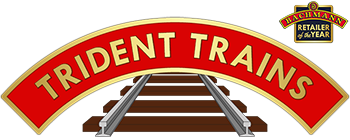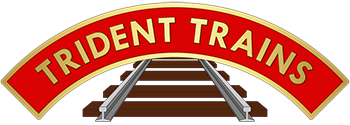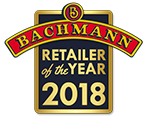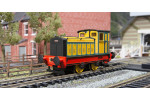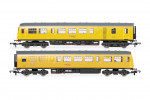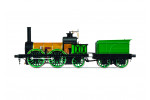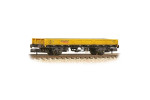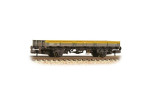Search results
 R3894
R3894North British Distillery Co. Ltd, Ruston & Hornsby 88DS, 0-4-0, No. 4
Ruston & Hornsby Ltd, of Lincoln, was formed as the result of the merger between Ruston, Proctor & Co. Ltd and Richard Hornsby & Sons Ltd on September 11, 1918 and their first narrow gauge diesel locomotive left the works on September 1, 1931. In the summer of 1932, production was moved to the larger Boultham Works, where the firm were eventually to become Britain's largest builder of diesel locomotives, with over 6,500 being built by the time production ceased in 1969. Almost as soon as the firm's 44/48HP 0-4-0 locomotives were making an appearance, an upgraded, more powerful 0-4-0 was on the drawing board.
Although many of the features of the 44/48HP were retained for the new 80/88HP, such as the chain drive and running gear, a new type of transmission was fitted, along with Westinghouse airbrakes. The new power unit, Ruston's own 4VPB, delivered 80BHP at 1000rpm and was later supplanted by Ruston's improved 4VPH that delivered 88BHP, but it required compressed air to be injected into the cylinders to be able to start. While running, an air reservoir was kept charged via the braking system, but after standing idle for a period the reservoir depleted and a secondary source was required to recharge the reservoir. This was achieved by fitting a small, secondary 1½HP 'donkey' engine, giving rise to a distinctive raised cover on the right hand side of the engine compartment that differed in size and placement depending on the make of engine used. Two basic weight options were offered for the 80/88HP, of 17 tons and 20 tons, the difference being achieved by attaching weights to the outside frames, as well as to the front and rear buffer beams.
In 1941, Ruston's locomotive classifications were changed, with the 80/88HP becoming 88DS (with the narrow gauge versions being assigned the DSM and DSN suffix, and the broader gauges assigned DSW). Outward appearance changes to the 'standard' locomotives were mainly confined to the cab area, with examples from mid-1947 replacing the open cab with a fully enclosed cab that featured several ad-hoc styles of front window. The final 88DS, 518494, left Boultham Works on 29 November 1967, bringing to an end a production run of 271 locomotives.
Ruston 421415 was built new for the North British Distillery Co. Ltd, being delivered in March 1958 to their distillery in the Gorgie district of Edinburgh, around the period when the distillery was expanding to include the former Edinburgh Corporation Tramways depot. In 1973, the locomotive was donated to the fledgling Fife Railway Preservation Group, who located it at the Lochty Private Railway until its demise in 1994. 421415, now numbered NBD No. 4, has now been restored and wears the livery of the North British Railway.
 R30195
R30195RailRoad Plus Network Rail, Class 960, Bo-Bo, 901002 'Iris 2'
Constructed in Birmingham, the Class 101 DMU was one of the longest lasting DMUs to ever see service in the UK. 527 of the class would be built across many orders from BR between 1956 and 1960. The first units would enter BR service in 1956 in the BR green livery.
Class 101 units at the height of their use could be seen in all corners of the UK, at the onset of privatisation in the 1990s the units would appear in all manner of colourful liveries such as the Network South East colours and First North Western. Throughout their life, Class 101 units would occasionally appear as a three car sets where demand dictated.
Beginning life as the BR Class 101 unit 50338 On its entry into departmental service the unit would be reclassified as a class 960 and renumbered 901002, it would also gain the name Iris 2 which would be displayed in place of a destination on its destination boards.
Iris 2 functioned as a lab for Network Rail undertaking tests around the UK. As Iris 2, the DMU appeared in a Serco Railtrack livery, Network Rail livery and a unique grey Lab 19 livery. Iris 2 is currently preserved on the Barry Tourist Railway in a BR Green livery.
 R30348
R30348L&MR, No. 58 'Tiger'
Number 58 'Tiger' was the sister engine to 'Lion', one of a plethora of locomotives named after animals as became the norm for the fledgling L&MR. Like its sister engine, 'Tiger' was designed as a luggage engine and was delivered from Todd, Kitson, and Laird alongside 'Lion', having been constructed at the same time as part of the same order. These were the first two locomotives to be built at the Railway Foundry in Leeds.
Information regarding 'Tiger' is scant, but as it was built to the same specifications, it is a reasonable assumption that the engine would have served the same duties as its more notable sister. It is also likely that the engine was also rebuilt at Edge Hill in 1841.
Likely still in service when the L&MR was absorbed into Grand Junction Railway and then the London and North Western Railway, 'Tiger' would have also been renumbered under its new operator. As it is not in preservation, it is assumed that at the time 'Lion' was withdrawn and converted into a stationary pump, 'Tiger' was also withdrawn and scrapped.
 377-731A
377-731ABR SPA Open Wagon Network Rail Yellow [W]
 377-730B
377-730BBR ZAA 'Pike' Open Wagon BR Engineers Grey & Yellow [W]
